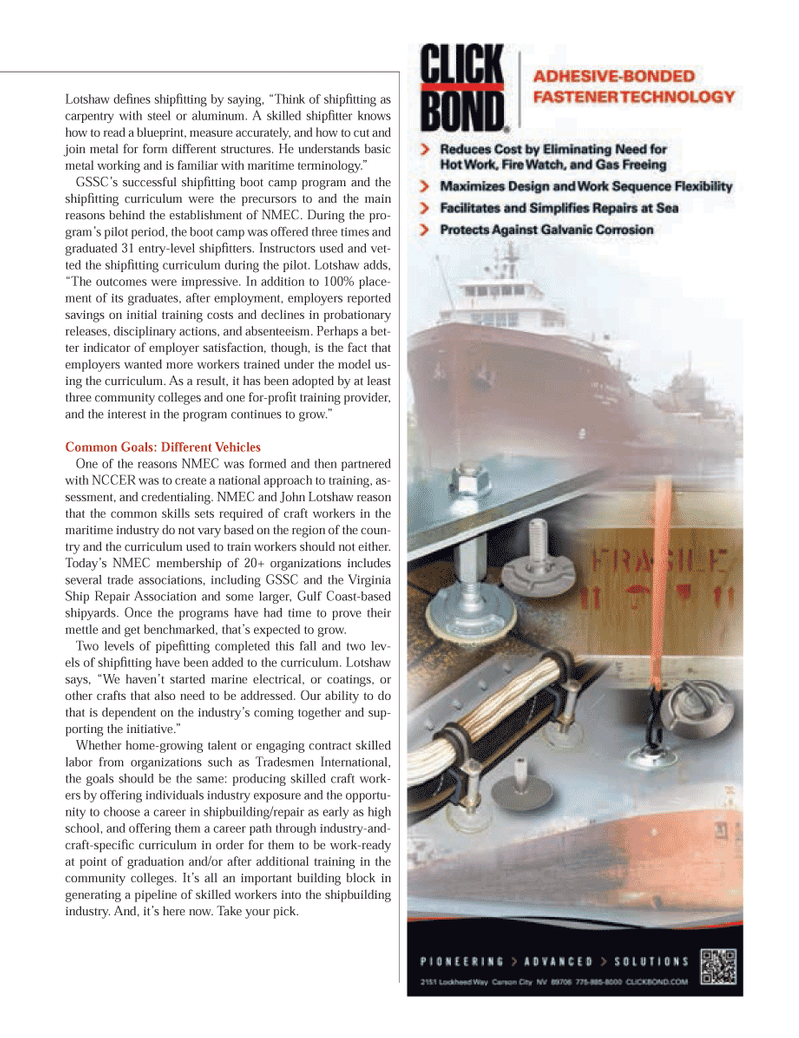
Page 29: of Maritime Logistics Professional Magazine (Q4 2013)
Shipbuilding, Repair
Read this page in Pdf, Flash or Html5 edition of Q4 2013 Maritime Logistics Professional Magazine
Lotshaw deÞ nes shipÞ tting by saying, ÒThink of shipÞ tting as carpentry with steel or aluminum. A skilled shipÞ tter knows how to read a blueprint, measure accurately, and how to cut and join metal for form different structures. He understands basic metal working and is familiar with maritime terminology.Ó GSSCÕs successful shipÞ tting boot camp program and the shipÞ tting curriculum were the precursors to and the main reasons behind the establishment of NMEC. During the pro-gramÕs pilot period, the boot camp was offered three times and graduated 31 entry-level shipÞ tters. Instructors used and vet- ted the shipÞ tting curriculum during the pilot. Lotshaw adds, ÒThe outcomes were impressive. In addition to 100% place- ment of its graduates, after employment, employers reported savings on initial training costs and declines in probationary releases, disciplinary actions, and absenteeism. Perhaps a bet-ter indicator of employer satisfaction, though, is the fact that employers wanted more workers trained under the model us- ing the curriculum. As a result, it has been adopted by at least three community colleges and one for-proÞ t training provider, and the interest in the program continues to grow.Ó Common Goals: Different Vehicles One of the reasons NMEC was formed and then partnered with NCCER was to create a national approach to training, as- sessment, and credentialing. NMEC and John Lotshaw reason that the common skills sets required of craft workers in the maritime industry do not vary based on the region of the coun- try and the curriculum used to train workers should not either. TodayÕs NMEC membership of 20+ organizations includes several trade associations, including GSSC and the Virginia Ship Repair Association and some larger, Gulf Coast-based shipyards. Once the programs have had time to prove their mettle and get benchmarked, thatÕs expected to grow. Two levels of pipeÞ tting completed this fall and two lev- els of shipÞ tting have been added to the curriculum. Lotshaw says, ÒWe havenÕt started marine electrical, or coatings, or other crafts that also need to be addressed. Our ability to do that is dependent on the industryÕs coming together and sup- porting the initiative.Ó Whether home-growing talent or engaging contract skilled labor from organizations such as Tradesmen International, the goals should be the same: producing skilled craft work- ers by offering individuals industry exposure and the opportu- nity to choose a career in shipbuilding/repair as early as high school, and offering them a career path through industry-and- craft-speciÞ c curriculum in order for them to be work-ready at point of graduation and/or after additional training in the community colleges. ItÕs all an important building block in generating a pipeline of skilled workers into the shipbuilding industry. And, itÕs here now. Take your pick. MP #4 18-33.indd 29MP #4 18-33.indd 2912/11/2013 3:02:25 PM12/11/2013 3:02:25 PM

 28
28

 30
30
